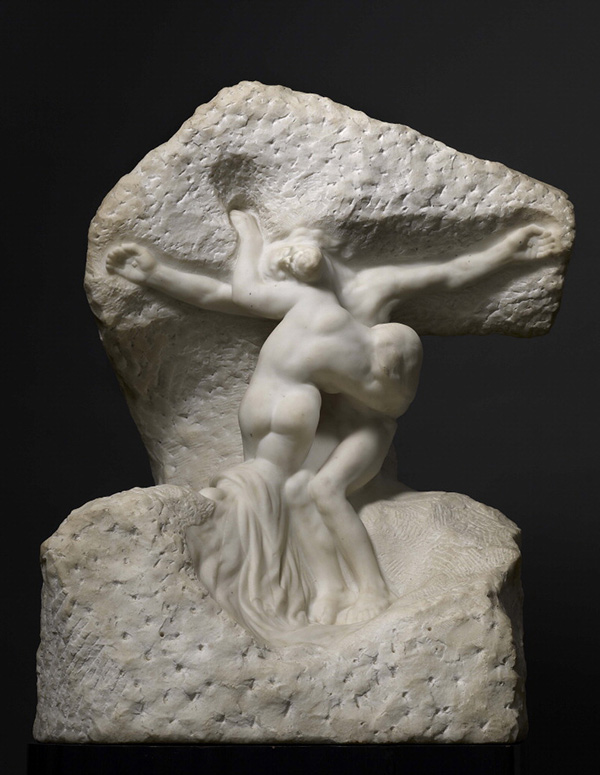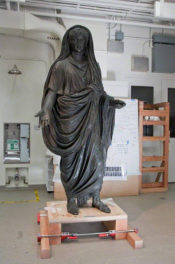In April 2019 Manet’s Spring (Jeanne Demarsy) traveled to Chicago to be featured in the exhibition Manet and Modern Beauty at the Art Institute of Chicago. Jeanne returns to Los Angeles in October 2019, when the exhibition opens at the Getty Center. —Ed.

Jeanne (Spring), 1881, Édouard Manet. Oil on canvas, 29 1/8 x 20 ¼ in. The J. Paul Getty Museum, 2014.62. Digital image courtesy of the Getty’s Open Content Program
In announcing the Getty’s recent acquisition of Jeanne (Spring) of 1881 by the French painter Édouard Manet I used the word “landmark” to describe the importance of this addition to our already spectacular collection of late-19th-century French paintings—the era of so many of the all-time most famous artists, such as Monet, Renoir, Degas, Van Gogh, Gauguin, and Cezanne. I hesitated in using a word that smacks of cliché—indeed it is a mainstay of press-release rhetoric—but in this case it really sticks.
Manet was the ultimate painter’s painter: totally committed to his craft, solidly grounded in the history of painting and yet determined to carve out a new path for himself and for modern art. He wanted both to rival the old masters at their own game and to lead a paradigm-shifting avant-garde. Alone of his contemporaries (the only one who comes near is Degas), Manet achieved this almost impossible balancing act, absorbing and channeling the achievements of the past into a radically new vision of what painting could be.
It was not a way to win easy friends. The traditionalists who controlled the official Salon exhibitions and refused most of the paintings that Manet submitted were scandalized by his work (Jeanne is one of the few exceptions). And the main rebel group of his day, the Impressionists, while greatly admiring his paintings and trying unsuccessfully to persuade him to exhibit with them, did not share or really understand Manet’s stylistic echoing of Velázquez, Goya, and other historical figures. With the benefit of hindsight, we can see him as the pivotal genius of the late 19th century; but for many at the time Manet seemed either not old-masterish enough, or still somewhat shackled to the past.

Jeanne (Spring), 1881, Édouard Manet. Oil on canvas, 29 1/8 x 20 ¼ in. The J. Paul Getty Museum
Jeanne was one of only two paintings that Manet exhibited at the Salon exhibition of 1882, together with another now-famous work, The Bar at the Folies-Bergère. Sadly, this was to be his last hurrah, as the artist died the next year, aged only 51, from syphilis after the horrific amputation of his leg. This was as tragic professionally as it was personally, for Manet was just beginning to receive the official recognition he had strived for all his career. In 1881 he was awarded a second-class medal at the Salon, and—an even greater honor—inducted into the national Legion of Honor. So the rave reviews he received for Jeanne not only gave Manet one of his rare moments of universal, unadulterated acclaim but would have put the seal on a turning point in his career—no longer a troublesome aspirant but a celebrated arrivé.

With curator Scott Allan (left) in the Getty Center’s West Pavilion, home to the newly installed Jeanne
It is easy to see why. There is nothing not to like about this painting, whatever one’s artistic predilections. The scene is bright and uplifting: a beautiful young actress, Jeanne Demarsy, dressed for her promenade in the height of fashionable attire. The brushwork is lively and expressive but so technically assured, even in its calculated flicks, daubs, and smudges, that it is clearly the work of a supreme master. So popular was it that Jeanne became the subject of one of the first color photographs of a work of art. Its acquisition by the Getty brings to Los Angeles the most important—and beautiful!—painting by this artist left in private hands and one of the great masterpieces of late-19th-century art.

Detail of brushwork and texture on Jeanne Demarsy’s sleeve
If you had to choose a sculptor of the same era who represented the equivalent turning point in three-dimensional art, it would undoubtedly be Rodin. And, as it happens, we recently acquired a work by him too—a wonderful, sensuous marble representation of Christ and Mary Magdalene of 1908. So when you visit the Getty Center to see Manet’s Jeanne, be sure also to see the special installation of the Rodin. In these two works you see the germ of modern art as we know it. And that surely counts as a landmark.

Christ and Mary Magdalene, 1908, Auguste Rodin. Marble, 43 x 33 1/2 x 31 in. The J. Paul Getty Museum, 2014.32




the artwork is beautiful
Thank you to the Getty for buying this painting and bringing it into the public view. It is a significant accomplishment by Manet–and he was surely a master painter who could paint anything. From a fish on a sideboard to citizen philosophers, he strove for culture meaning in his works, much more so that other Impressionists.